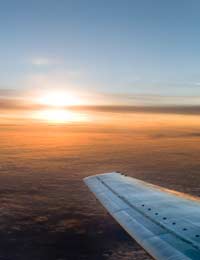Flying at the End of the Next Century?

A major European airline recently asked industry experts what they thought the business traveller would experience when flying toward the end of the next century and the answers were varied to say the least.
Ecology and the Business Traveller
The ecological impact of commercial flight was discussed a great deal but predictably, none of the experts thought that there would be no flying at all. Despite the environmental objections, the genie is unlikely to be put back in the bottle.With one estimate of 5-10% annual growth in flying miles and another of airline traffic generally doubling every ten to fifteen years, the challenge is seen as making more efficient engines, with different fuels, and different aircraft forms.
It seems unlikely that industry experts take seriously the threat of telecommunications technology. It was considered that business will become more global and that meeting face-to-face would still be important enough to make video-conferencing, Internet seminars and the like adjuncts to flying rather than replacements.
Aircraft Shapes will Deliver More Comfort
The consensus was that the shape of aircraft will remain broadly similar for the coming decades with attention being paid to stronger but lighter composite materials for the structure of the aircraft and greater use of electronic controls to eek more fuel out of the engines. It is anticipated that toward the end of the century we will see radical shapes that are aerodynamically more efficient and hold themselves up in the air better than today's shapes.This in turn means that they will require less fuel. Shapes are expected to evolve that are more like flying wings, with the whole body of the plane contributing to lift. These will provide larger spaces than the confined tubular fuselages of today, allowing the business traveller to stretch out and exercise more easily.
Technological Advances
The growth of nanotechnology is expected to deliver more slippery surfaces and perhaps surfaces that change throughout the flight, ultra-smooth at cruising height then roughening up to increase drag on landing. There are likely to be solar cells on the top surfaces that provide electrical power so there's less of a load on the engines.Another off-the-wall prediction is that computation would have advanced so dramatically that aircraft will be able to determine wind speeds and air currents at various heights and locations. They will then be able to adjust their flight paths dynamically to take advantage of beneficial air movements, increasing fuel economy once more.
Bigger and Better?
The size of aircraft will continue the upward trend to lessen the ecological cost per traveller and some designs are expected to hold up to two and a half thousand passengers. But this will put pressure on airports to increase capacity and throughput, otherwise the business traveller will be having a very stressful time toward the end of the century.Finally it remains to be seen whether the recent trend towards ultra-luxurious and spacious cabins for the business traveller will continue. It is either a move to provide a better experience to compete for the business traveller's miles or the decadent end of a global boom that has just spectacularly bust.
- Business Flying to the Americas
- Business Flying to Africa
- Business Flying to the Middle East
- Top Tips for Flying on Business
- Which Class Should Business Travellers Use?
- Membership Schemes for Business Flyers
- Getting a Flight Upgrade When Flying for Business
- Flying to Asia on Business
- Business Flying to Japan and the Far East
- Business Flying to Australasia
- Flying to Europe on Business


Re: Driving for Business Around the UK
@peterM - check for any apps on the apple or play store. Also contact the satnav providers - or check out functionality on…
Re: Driving for Business Around the UK
Is there a satnav blue-tooth link to a tablet allow route planning on the tablet on various scale map, with easy transfer…
Re: Keep Fit Advice for Business Travellers
all of this makes a lot of sense, my brother inlaw travels a lot on business and always seems to put on a few pounds…